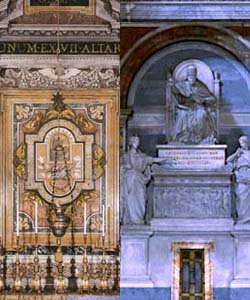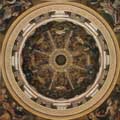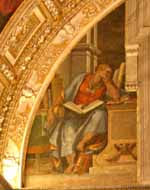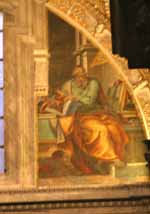| Grottoes
Vatican City Colonnade Saints Floorplan #2 |
| Altars
Monuments The History |
| Related
Items St Jerome Altar |
 |
The Gregorian Chapel is named after its patron Gregory XIII. It contains the tombs of Benedict XIV and Gregory XVI. The three altars here are: St. Basil, Madonna of Succour and St. Jerome |
From: 'St. Peter's - Guide to Basilica and Square'
At the intersection with a transept is the Gregorian Chapel, which is
named after Gregory VIII (1572-1585), the Pontiff who commissioned Giacomo
Della Porta (1540-1602) to complete this work which had been begun by
Michelangelo and continued by Barozzi and Vignola. It has been described
as "the most beautiful chapel in the world" because of all its marbles,
mother-of-pearl, precious stones, gilded bronze, multi-colored mosaics
and stucco ornamentation. Its dome is 42 m. high.
On the back wall is the Altar of Our Lady of Succor, embellished with the rarest alabaster, amethysts and other semi-precious stones, and four superb columns of African marble and green porphyry, the work of G. Muziano (1528-1592). It is called after the 12th-century fresco framed above the altar, brought here by Gregory XIII in 1578. The remains of St. Gregory of Nazianzus (d. 390), one of the great theologians from Cappadocia, are preserved in a porphyry urn beneath the altar. He is shown in the spandrels, together with St. Gregory the Great, St. Basil the Great and St. Jerome.
The chapel is adorned with splendid mosaics made mainly by Marcello Provenzale after designs by Girolamo Muziano, and by Salvatore Monosilio after designs by Nicola La Piccola. In the lunettes are the Annunciation and the Prophets Isaiah and Ezekiel; in the pendentives are the Latin Doctors St. Jerome and St. Gregory the Great, and the Greek Fathers, St. Basil and St. Gregory of Nazianzus.
From:
'St. Peter's Basilica - A Virtual Tour' by Our
Sunday Visitor
Turning right, we enter the Gregorian Chapel, the first in Michelangelo's
construction to be completed, by Giacomo della Porta on the wishes of
Gregory XIII; his coat of arms is before the altar dedicated to St. Mary
of the Succor (Our Lady of Perpetual Help), whose image, formerly in the
St. Leo Oratory in the old Basilica, was moved here in 1578.
Built with a profusion of rich furnishings, using various kinds of marble and gems, bronze and stucco ornaments, this chapel can be considered a church within the church. It is surmounted by a round dome 42 meters high - one of the four identical domes placed on the corners of the Basilica - decorated between the windows of its tambour by allegories and symbols of the Virgin Mary, by Salvatore Monosilio in the 18th century. More valuable are the corbels by Girolamo Muziano, a valid master contemporary of Michelangelo, who in them illustrated the Fathers of the Latin Church, St. Gregory and St. Jerome, and those of the Greek Church, St. Basil and St. Gregory of Nazianzus with dignified solemnity.
In the lunette over the altar at the sides of the window, Marcello Provenzale realized an Annunciation, later partially replaced by Nicola La Piccola.
From:
'THE NEW SAINT PETER'S'
Next we continue to the right, where we find the large Cappella Gregoriana,
with the image of the Madonna del Soccorso (11th century) over the altar.
The urn under the altar contains the body of Saint Gregory Nazianzen,
brought here in 1580 from the Benedictine monastery in the Campo Marzio.
The event is commemorated in one of the frescoes on the third floor of
the Loggias of the Vatican Palace. Its precious marbles and gems make
this chapel "the most beautiful and richest in the world", as people said
at that time.
Next to it, at the entrance to the chancel, is the monument to Gregory XVI, in a static neoclassical style. The so-called "Gregorian" cupola, designed by Vignola and redone by della Porta, as was explained above, was decorated by Marcello Provenzale. We have no certain information about the ornamentations around the cupola. They are attributed to Nebbia, Calandra, Romanelli, Muziano and Pellegrini - Fontana ascribes them to Michelangelo himself. It is revealing to note that only 60 years after the work was done the artists' names were forgotten.




